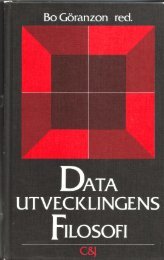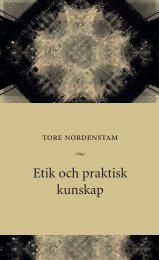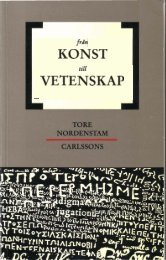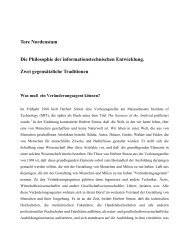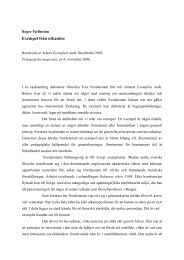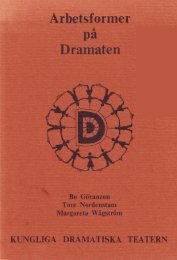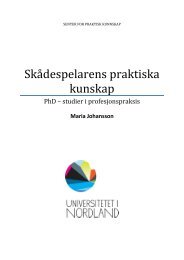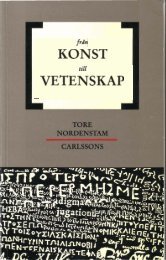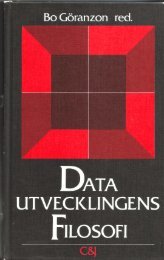tore nordenstam explanation and understanding in the history of art
tore nordenstam explanation and understanding in the history of art
tore nordenstam explanation and understanding in the history of art
You also want an ePaper? Increase the reach of your titles
YUMPU automatically turns print PDFs into web optimized ePapers that Google loves.
3.1. A pragmatic perspective<br />
The <strong>in</strong>tentionalist pattern seems to take care <strong>of</strong> at least one important type <strong>of</strong> <strong>explanation</strong><br />
<strong>in</strong> <strong>the</strong> human sciences. Yet many philosophers have felt that <strong>the</strong> <strong>in</strong>tentionalist pattern as<br />
presented e.g. by Dray <strong>and</strong> von Wright is unsatisfactory. The dissatisfaction may <strong>in</strong> some<br />
cases be expla<strong>in</strong>ed by <strong>the</strong> critics’ commitment to ano<strong>the</strong>r pattern <strong>of</strong> <strong>explanation</strong>, which<br />
<strong>the</strong>y tend to regard as <strong>the</strong> basic pattern <strong>of</strong> <strong>explanation</strong>. Their strategy will <strong>the</strong>n be to try to<br />
show that <strong>in</strong>tentionalist <strong>explanation</strong>s may be reduced to <strong>the</strong> deductive-nomological<br />
pattern. More <strong>in</strong>terest<strong>in</strong>g from our po<strong>in</strong>t <strong>of</strong> view is <strong>the</strong> reaction <strong>of</strong> a philosopher like Karl-<br />
Otto Apel, who feels dissatisfied with <strong>the</strong> exist<strong>in</strong>g presentations <strong>of</strong> <strong>the</strong> <strong>in</strong>tentionalist<br />
pattern without be<strong>in</strong>g committed to <strong>the</strong> view that deductive - nomological <strong>explanation</strong>s<br />
play a crucial role <strong>in</strong> all sciences. When von Wright proposes that <strong>the</strong> <strong>in</strong>tentionalist<br />
pattern <strong>of</strong> <strong>explanation</strong> plays <strong>the</strong> same key role <strong>in</strong> <strong>the</strong> human sciences as <strong>the</strong> deductivenomological<br />
pattern does <strong>in</strong> <strong>the</strong> natural sciences, Apel suspects a hidden commitment to<br />
ideals which belong properly to <strong>the</strong> natural sciences but not to <strong>the</strong> hermeneutic<br />
discipl<strong>in</strong>es (i.e. those human sciences <strong>in</strong> which underst<strong>and</strong><strong>in</strong>g plays a central role). The<br />
ideal which belongs properly to <strong>the</strong> natural sciences but not to <strong>the</strong> hermeneutical<br />
discipl<strong>in</strong>es is <strong>the</strong> production <strong>of</strong> <strong>the</strong>oretical <strong>explanation</strong>s which constitute answers to<br />
questions <strong>of</strong> <strong>the</strong> type “Why was x to he expected ?” The very attempt to f<strong>in</strong>d an<br />
explanatory pattern which is to <strong>the</strong> human sciences what <strong>the</strong> deductive-nomological<br />
pattern is to <strong>the</strong> natural sciences (accord<strong>in</strong>g to <strong>the</strong> received view) “seems to <strong>in</strong>volve <strong>the</strong><br />
hidden motive <strong>of</strong> a scientistic parallelism <strong>of</strong> <strong>the</strong>oretically explanatory arguments”,<br />
accord<strong>in</strong>g to Apel. 79<br />
The tacit assumption which is made both by von Wright <strong>and</strong> his critics is (Apel suggests)<br />
that all sciences are guided by <strong>the</strong> same lead<strong>in</strong>g question <strong>of</strong> research, viz. to answer<br />
questions <strong>of</strong> <strong>the</strong> “why to be expected”-type. As aga<strong>in</strong>st this, Apel wishes to stress that<br />
“with<strong>in</strong> <strong>the</strong> humanities we have an autonomous <strong>in</strong>terest <strong>in</strong> underst<strong>and</strong><strong>in</strong>g what k<strong>in</strong>d <strong>of</strong><br />
79 K.-O. Apel, ”Causal Explanation, Motivational Explanation, <strong>and</strong> Hermeneutical Underst<strong>and</strong><strong>in</strong>g.<br />
(Remarks on <strong>the</strong> Recent Stage <strong>of</strong> <strong>the</strong> Explanation-Underst<strong>and</strong><strong>in</strong>g Controversy)”, <strong>in</strong> G. Ryle, ed.,<br />
Contemporary Aspects <strong>of</strong> Philosophy, Oriel Press, London 1977, p. 175. (A longer version <strong>of</strong> this paper<br />
exists <strong>in</strong> mimeographed form, dated Autumn 1975.)






